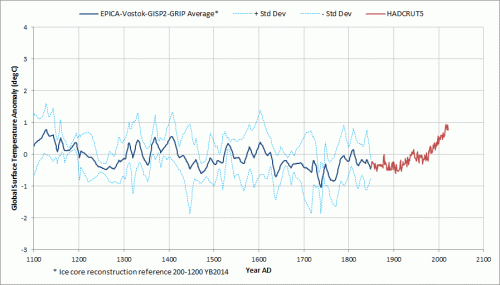The Holocene geological epoch starts at the beginning of the current interglacial warm period about 11,700 years ago and continues to the present. As discussed in previous posts, the current interglacial warm period is the fifth interglacial in the last 500,000 years that was dominated by four intervening glacial periods each lasting about 80,000 to 120,000 years. See the previous posts for more details.
Several ice core climate analyses covering the Holocene are available from the US NOAA/NCDC Paleoclimatology Program. Temperature reconstructions from four of these ice core analyses are presented in the graph below in Figure 1. Two are from Antarctica, EPICA (Jouzel 2007) and Vostok (Petit 2001), and two are from Greenland, GISP2 (Alley 2000) and GRIP (Vinther 2011). The graph data are presented as anomalies relative to each data-set average for the 1,000 year period from 200 to 1,200 years before the present (2014) as the zero baseline. Also shown in red on the graph are the annual HadCRUT4 global temperature anomalies estimated from temperature measurements provided by the UK Meteorological Office Hadley Centre which are referenced to a 1961-1990 zero baseline.
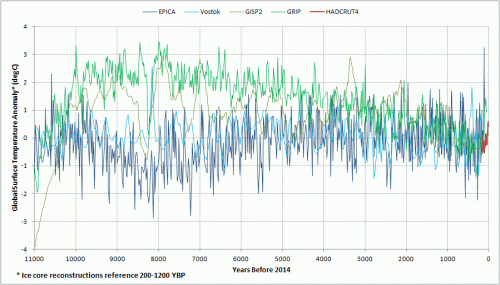
Figure 1. Comparison of surface temperature reconstructions for the last 11,000 years based on oxygen isotope ratio analyses of ice cores from Antarctica (EPICA and Vostok) and from Greenland (GISP2 and GRIP) along with the more recent HADCRUT4 global surface temperature anomaly analysis (click to enlarge).
Since these ice core climate reconstructions are likely to be more representative of regional climate rather than global climate, two reconstructions were selected for each hemisphere for comparison. The southern hemispheric Antarctic reconstructions can be compared to each other and to the northern hemispheric Greenland reconstructions which can also be compared to each other for consistency and variability. This is a crude attempt to characterize the general global climate, analogous to selecting data from two weather stations in Antarctica and two in Greenland to estimate modern global temperature anomalies and thus is likely to have some large uncertainties for this purpose.
In general, all of the reconstructions show frequent variations in temperature of plus or minus one to two degrees Centigrade(C) about the reference baseline and show much wider variation than what has been seen for global climate in the most recent 164 years as indicated by the HadCRUT4 data. Temperature variations tend to be larger over time in polar regions than near the equator, so global average temperature variations are not likely to have been as large. However, even considering the large uncertainties in the accuracy of the reconstructions and their relevance to global average temperatures, the implication is that climate variations much larger than those seen in the most recent industrial era may have been quite common in the past during the Holocene with no influence from human activities. As a consequence, trying to separate a relatively small human-induced climate signal from the large natural climate variation noise may not be as easy as some researchers claim.
It is also interesting to note the general divergence of the Greenland versus Antarctic climate reconstructions during the period from about 4,000 to 11,000 years ago with the largest separation about 8,000 years ago when much warmer anomalies are indicated in Greenland than in Antarctica.
Figure 2 shows the most recent 4,000 years in more detail. This graph uses the same normalized temperature anomaly data as in the previous graphs, except the GISP2 data are from a higher temporal resolution reconstruction based on deuterium and argon isotope analyses (Kobashi 2011). During this period the ice core climate reconstructions show considerable variation ranging from -3C to +4C. The temperature anomalies from 2,000 to 4,000 years ago averaged about 0.5C above the reference normal for 200 to 1,200 years ago, which may be comparable to very recent temperatures in the last ten years.

Figure 2. Comparison of surface temperature reconstructions for the last 4,000 years based on oxygen isotope ratio analyses of ice cores from Antarctica (EPICA and Vostok) and from Greenland (GISP2 and GRIP) along with the more recent HADCRUT4 global surface temperature anomaly analysis (click to enlarge).
Looking back at the most recent 2,000 years, Figure 3 below again shows considerable variation in temperatures over relatively short time periods. This graph presents the same data used in Figure 2. As mentioned previously, the rapid variations in temperature may be more indicative of local climate variations than of global climate variations since these shorter variations do not correlate very well between data sets. Uncertainty in the age estimates and variable amounts of smoothing between the data sets may also come into play.
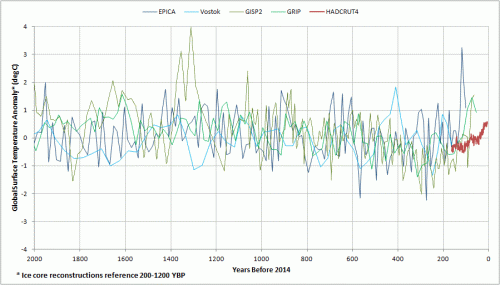
Figure 3. Comparison of surface temperature reconstructions for the last 2,000 years based on oxygen isotope ratio analyses of ice cores from Antarctica (EPICA and Vostok) and from Greenland (GISP2 and GRIP) along with the more recent HADCRUT4 global surface temperature anomaly analysis (click to enlarge).
To better estimate the global temperature average during the last 2,000 years, the four ice core climate reconstructions presented in Figure 3 were interpolated by year and averaged together for each year over the last 2,000 years. The resulting global climate reconstruction is shown below in Figure 4, with plus and minus one standard deviation as a rough indication of uncertainty. Coincidentally, the composite ice core global temperature reconstruction matches nicely with the HadCRUT4 temperature where they meet in 1850. The implication is that the HadCRUT4 reference normal period of 1961-1990 may closely correspond to the ice core reconstruction reference normal for 200 to 1,200 years ago.
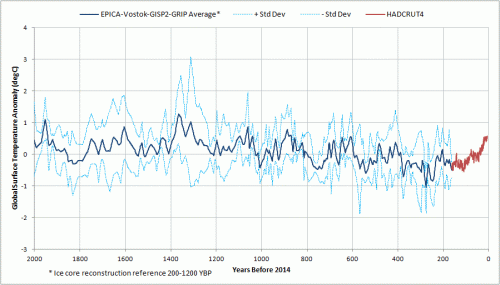
Figure 4. Composite of EPICA, Vostok, GISP2, and GRIP ice core surface temperature reconstructions referenced to the 1000 year period ending 200 years ago and compared with the recent HADCRUT4 global surface temperature anomaly analysis (click to enlarge).
For easier interpretation relative to history, Figure 5 shows the same data as Figure 4, but scaled in years AD with increments marked for each century. Note that year 0 in Figure 5 is actually year -1, since there is no year 0.
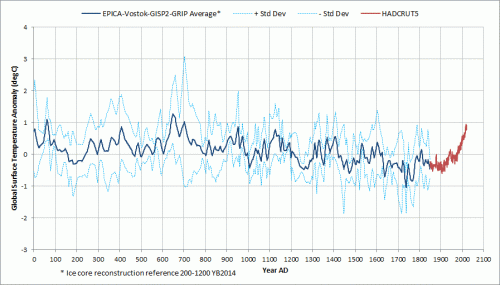
Figure 5. Composite of EPICA, Vostok, GISP2, and GRIP ice core surface temperature reconstructions referenced to the 1000 year period ending 200 years ago and compared with the recent HADCRUT4 global surface temperature anomaly analysis, with scale in years AD (click to enlarge).
The composite is considerably less variable than the individual data sets, but even the remaining variability may still include a fair amount of “noise” rather than accurately depicting global temperature variations. Nevertheless, the composite does suggest a possible warmer period globally from about 250 AD to about 1000 AD and a cooler period from about 1200 AD to about 1950 AD. There is a hint of the “Little Ice Age” with the coldest period from about 1630 AD to 1780 AD when the composite temperature is mostly in the range from 0.3C to 1.0C below the reference normal. The warmest period indicated by the composite was from about 625 AD to 720 AD where the estimated global temperature was about 0.5C to 1.3C above the reference normal. For comparison, the HadCRUT4 estimated global temperature anomaly has been near 0.5C for 2005-2014 AD. The peak period from about 640-660 AD may possibly have been as much as 0.5-0.8C warmer than our 2005-2014 AD average and without any human influence.
This analysis reinforces my suspicion that global climate variability from natural causes can easily exceed what has been observed in the current industrial era, making it difficult to confidently estimate the human influence, if any.
Update through 2023
Figure 5 above has been updated to include the HadCRUT5 global surface temperature anomaly estimates through 2023. Also Figure 6 has been added below to provide a closer view of the current 1,000 year period ending 2100.

